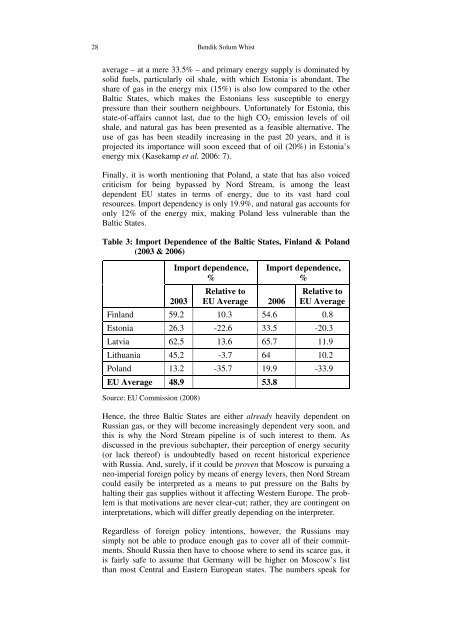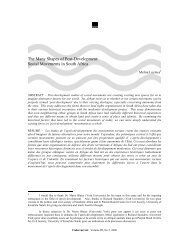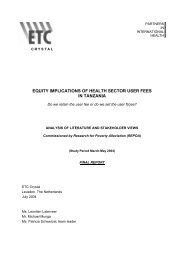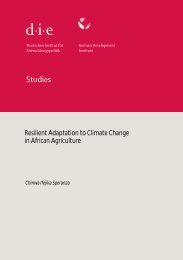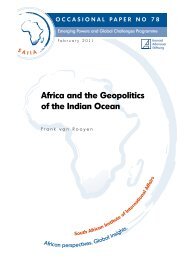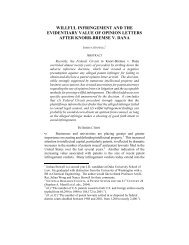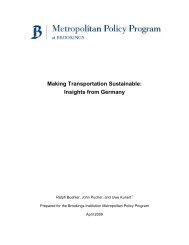Nord Stream: Not Just a Pipeline
Nord Stream: Not Just a Pipeline
Nord Stream: Not Just a Pipeline
Create successful ePaper yourself
Turn your PDF publications into a flip-book with our unique Google optimized e-Paper software.
28 Bendik Solum Whist<br />
average – at a mere 33.5% – and primary energy supply is dominated by<br />
solid fuels, particularly oil shale, with which Estonia is abundant. The<br />
share of gas in the energy mix (15%) is also low compared to the other<br />
Baltic States, which makes the Estonians less susceptible to energy<br />
pressure than their southern neighbours. Unfortunately for Estonia, this<br />
state-of-affairs cannot last, due to the high CO2 emission levels of oil<br />
shale, and natural gas has been presented as a feasible alternative. The<br />
use of gas has been steadily increasing in the past 20 years, and it is<br />
projected its importance will soon exceed that of oil (20%) in Estonia’s<br />
energy mix (Kasekamp et al. 2006: 7).<br />
Finally, it is worth mentioning that Poland, a state that has also voiced<br />
criticism for being bypassed by <strong>Nord</strong> <strong>Stream</strong>, is among the least<br />
dependent EU states in terms of energy, due to its vast hard coal<br />
resources. Import dependency is only 19.9%, and natural gas accounts for<br />
only 12% of the energy mix, making Poland less vulnerable than the<br />
Baltic States.<br />
Table 3: Import Dependence of the Baltic States, Finland & Poland<br />
(2003 & 2006)<br />
Source: EU Commission (2008)<br />
Import dependence,<br />
%<br />
2003<br />
Relative to<br />
EU Average 2006<br />
Import dependence,<br />
%<br />
Relative to<br />
EU Average<br />
Finland 59.2 10.3 54.6 0.8<br />
Estonia 26.3 -22.6 33.5 -20.3<br />
Latvia 62.5 13.6 65.7 11.9<br />
Lithuania 45.2 -3.7 64 10.2<br />
Poland 13.2 -35.7 19.9 -33.9<br />
EU Average 48.9 53.8<br />
Hence, the three Baltic States are either already heavily dependent on<br />
Russian gas, or they will become increasingly dependent very soon, and<br />
this is why the <strong>Nord</strong> <strong>Stream</strong> pipeline is of such interest to them. As<br />
discussed in the previous subchapter, their perception of energy security<br />
(or lack thereof) is undoubtedly based on recent historical experience<br />
with Russia. And, surely, if it could be proven that Moscow is pursuing a<br />
neo-imperial foreign policy by means of energy levers, then <strong>Nord</strong> <strong>Stream</strong><br />
could easily be interpreted as a means to put pressure on the Balts by<br />
halting their gas supplies without it affecting Western Europe. The problem<br />
is that motivations are never clear-cut; rather, they are contingent on<br />
interpretations, which will differ greatly depending on the interpreter.<br />
Regardless of foreign policy intentions, however, the Russians may<br />
simply not be able to produce enough gas to cover all of their commitments.<br />
Should Russia then have to choose where to send its scarce gas, it<br />
is fairly safe to assume that Germany will be higher on Moscow’s list<br />
than most Central and Eastern European states. The numbers speak for


